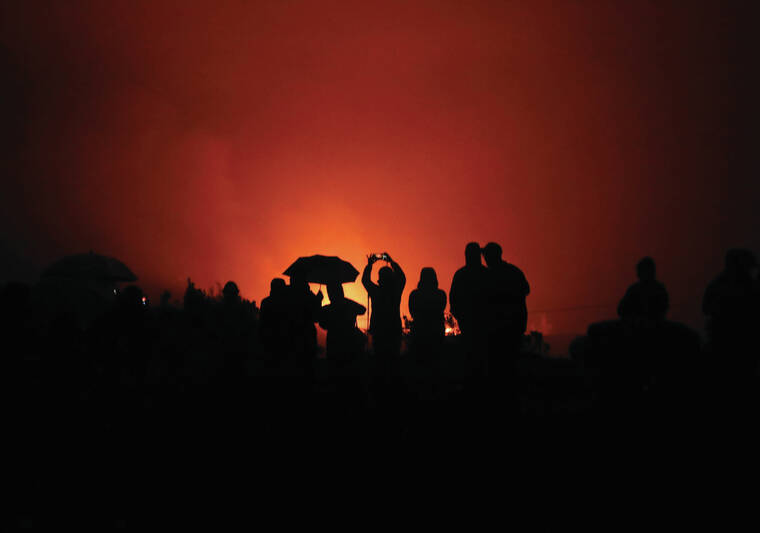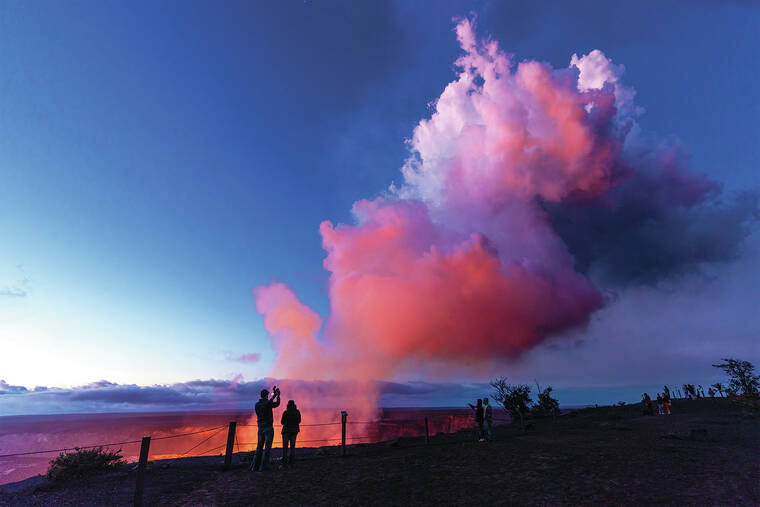Scientists and residents alike on Thursday will celebrate the one-year anniversary of the current volcanic eruption of Kilauea.
On Sept. 29 of last year, liquid lava returned to Halema‘uma‘u crater within Hawaii Volcanoes National Park about four months after the end of the previous summit eruption, which lasted from December 2020 until May 2021. At the time, the eruption produced nearly as much lava per second as it did during the 2018 Kilauea eruption.
Mike Zoeller, geologist with the Hawaiian Volcano Observatory, said the current eruption’s lava effusion rate has now slowed to about two to four cubic meters per second.
“The most important thing we’ve learned in the last year is that there’s a different mechanism to fill the caldera,” Zoeller said.
Zoeller said old accounts of Halema‘uma‘u describe the floor of the crater rising and falling at once, as though it is a single unit. Before the current eruption, he said, geologists were unsure what those accounts were referring to.
The current eruption makes it clear, however, Zoeller said. Lava emerges from a vent, flows across the lava lake and loses gas, which makes it denser and causes it to sink and deposit beneath the lake. As this process continues, the accumulation causes the lake to grow endogenously — meaning it grows from within, Zoeller explained.
This process is not dissimilar to the previous December 2020 eruption. Unlike that one, however, Zoeller said this eruption shows no signs of slowing.
“Our best explanation for why this one has lasted longer is that this surface vent has a better, more efficient connection with the magma reservoir,” Zoeller said. “As to why that is, we’re not sure.”
Zoeller said there have been occasional fluctuations with the eruption. Last Tuesday, for example, he said there were some minor earthquakes, and nearby tiltmeters recorded slight changes in ground movement. But, he said, such events are not uncommon and are probably caused by the vent being temporarily plugged and clearing again.
In any event, Zoeller said HVO has not detected signs that indicate the eruption will either intensify or weaken in the near future.
Meanwhile, the return of lava to Halema‘uma‘u has dovetailed with the weakening of the COVID-19 pandemic to prompt a surge of visitors to the volcano. HVNP spokeswoman Jessica Ferracane said via email that the park has had more than 1.5 million visitors since the eruption began last year, with the first eight months of 2022 bringing a 42% increase in visitors over the same months in 2021.
Ferracane added that the park is predicting “a very busy holiday season” this year.
Owners of Volcano businesses said the eruption has translated to very brisk business for them, although some speculated that, even if the eruption hadn’t happened, the end of COVID would have led to a surge in visitors regardless.
“Last year was our best year ever in 17 years,” said Shannon Fisher, owner and operator of Volcano bed-and-breakfast Aloha Crater Lodge. “I’m expecting this one to be a banner year, too.”
Fisher said her business is constantly booked by people specifically hoping to see the eruption at night, although she added that unlike past eruptions, there is less of a visible nighttime glow this time around.
Pua Norris, head innkeeper at the bed-and-breakfast Volcano Village Lodge, agreed, estimating that her business has had an 80% booking rate this year, compared to a roughly 75% rate in 2021.
“I think we’d be doing good even if the eruption didn’t happen,” Norris said. “So many people just want to travel. People who put off their vacations for a year are doing them this year.”
Gwendolyn Hill, president and owner of BikeVolcano.com, a Volcano-based business that rents e-bikes for guided tours at HVNP, said nearly all of her business is from visitors hoping to see the lava, and added that business is continuing to pick up even into the typically slow autumn season.
However, Hill said that outside of Volcano, the awareness of the eruption may not be as widespread.
“I think the tourism industry here has moved away from focusing on the eruption these days, when before it was the main thing it focused on,” Hill said, adding that HVNP is still not as regularly crowded as it was prepandemic during the 35-year eruption between 1983 and 2018. “I think they should — it’s still the biggest thing in the state people want to see.”
To commemorate the eruption, HVNP will hold an “After Dark in the Park” event at 7 p.m. Tuesday at the Kilauea Visitor Center, during which David Phillips, deputy scientist in charge at HVO, will discuss the science of the eruption, as well as a similar presentation at 3 p.m. Thursday at Uekahuna, just east of the former Jaggar Museum site.
Email Michael Brestovansky at mbrestovansky@hawaiitribune-herald.com.









